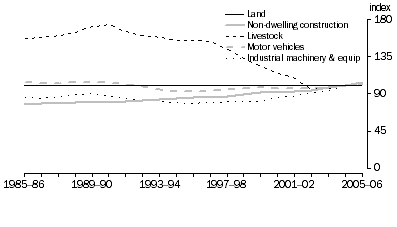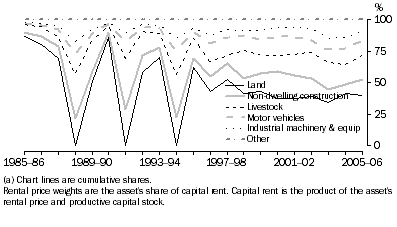APPENDIX:
Implications of land on Agriculture
A more intricate statistical issue is embedded within the capital story of this industry. Land is a significant component of the capital stock in the Agriculture, forestry and fishing industry, averaging around 60% of total net capital stock. This has an important implication for the calculation of capital services in this industry. This is because the productive capital stock volumes multiplied by their rental price are used to form the rental price weights for each asset.
This would pass without comment were it not for the dominance of the land in the productive capital stock and the necessity for occasionally constraining rental prices on this asset type in the calculation of capital services. An exogenous constraint is occasionally necessary because the annual endogenous calculation of rental prices on land sometimes results in a negative number. In these years, the rental price on land is constrained to 0.001 - an insignificantly small number to ensure that rental prices are always positive. Positive rental prices are required to form positive weights.
The weighting of different assets in the calculation of capital services varies based on the rental value of those assets. Given that the stock of land is very large and constant through time, that is, zero growth in the productive capital stock of land (figure 3.6), there will be very little change in the capital services indicator during normal periods when rents from land are sufficiently greater than zero. However, during periods of downturn, the rental price on land may approach zero and hence services flowing from other assets will make up a greater proportion of the capital services index. If there is a notable change in these other asset types (for instance, the accumulation of livestock or equipment), then the change in capital services as a whole will be more pronounced than if the rental price on land were normal. Further, it is unlikely that the assumption that the productive stock of land is unchanging over time holds true due to unmeasureed quality improvements to the land.
3.6 Agriculture, forestry & fishing productive capital stock, (2004-05 = 100)

This variation in the importance of the land has implications for the reported MFP estimates. For instance, during periods where rental prices on land are very low and where there is a greater than normal accumulation of other types of assets, the growth in the capital services index will be larger than had the rental price on land been sufficient for land to dominate the indicator (figure 3.7). This will mean that the combined input index will also be larger than otherwise and that MFP will be reported as less than otherwise. Conversely, the dominance of the land in the stock of capital also means that during periods when normal land rents are occurring and greater than normal accumulation of other asset types (such as machinery and livestock), the growth in capital services will be more muted. In turn, any change in MFP as a result of a change in output (from the application of the new capital) will be more pronounced.
3.7 Agriculture, forestry & fishing rental price weights (a)

Gross mixed income
As noted, the estimation of capital and labour shares of income is complicated in the Agriculture, forestry & fishing industry by the large unincorporated sector. This sector's output is measured as a combination of income from capital and labour (gross mixed income) and must be split into its two components to create factor shares of income.
The exogenous constraint on the rental price of land outlined above has an implication in the calculation of the capital rent component of gross mixed income. When the rental price is constrained, the capital share of income will be higher than otherwise (because capital income from the unincorporated sector will not decline linearly with GOS when a non-negativity constraint is applied to rental prices). This understates the growth in the input index used to calculate MFP and, consequently, to overstate growth in MFP itself.
 Print Page
Print Page
 Print All
Print All